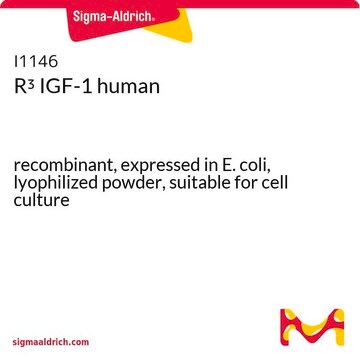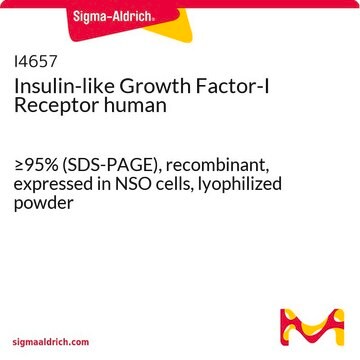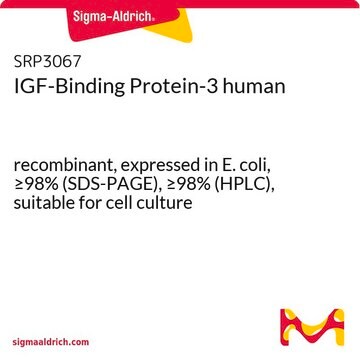I3769
Insulin-like Growth Factor-I human
≥95% (HPLC), recombinant, expressed in E. coli, lyophilized powder, suitable for cell culture
Synonym(s):
IGF, IGF-I, somatomedin c
About This Item
Recommended Products
Product Name
Insulin-like Growth Factor-I human, IGF-I, recombinant, expressed in E. coli, lyophilized powder, suitable for cell culture
biological source
human
Quality Level
recombinant
expressed in E. coli
assay
≥95% (HPLC)
form
lyophilized powder
potency
0.1-10 ng/mL ED50/EC50
quality
endotoxin tested
mol wt
~7.6 kDa
packaging
pkg of 50 and 100 μg
1 of 4
This Item | I2526 | SRP3069 | I4657 |
|---|---|---|---|
| biological source human | biological source human | biological source human | biological source human |
| assay ≥95% (HPLC) | assay ≥98% (SDS-PAGE and HPLC) | assay ≥95% (HPLC) | assay ≥95% (SDS-PAGE) |
| technique(s) cell culture | mammalian: suitable | technique(s) cell culture | mammalian: suitable | technique(s) cell culture | mammalian: suitable | technique(s) - |
| recombinant expressed in E. coli | recombinant expressed in E. coli | recombinant expressed in E. coli | recombinant expressed in NSO cells |
| Quality Level 200 | Quality Level 200 | Quality Level 300 | Quality Level 200 |
| form lyophilized powder | form lyophilized powder | form lyophilized powder | form lyophilized powder |
General description
Application
- in modified Dulbecco minimal essential medium for in vitro culture of testicular cells[2][3]
- in culture media, to study its effect on steroidogenesis during testicular development[4]
- in culture media for in vitro assay of splenic pro-erythroid cell growth and differentiation[5]
Biochem/physiol Actions
Physical form
Reconstitution
Analysis Note
related product
Storage Class
11 - Combustible Solids
wgk_germany
WGK 3
flash_point_f
Not applicable
flash_point_c
Not applicable
ppe
Eyeshields, Gloves, type N95 (US)
Choose from one of the most recent versions:
Certificates of Analysis (COA)
Don't see the Right Version?
If you require a particular version, you can look up a specific certificate by the Lot or Batch number.
Already Own This Product?
Find documentation for the products that you have recently purchased in the Document Library.
Customers Also Viewed
Articles
Insulin-like Growth Factors (IGF)
Protocols
Stem cell reprogramming protocols to generate human induced pluripotent stem cells (iPSCs) including viral and non-viral RNA based methods.
Our team of scientists has experience in all areas of research including Life Science, Material Science, Chemical Synthesis, Chromatography, Analytical and many others.
Contact Technical Service











